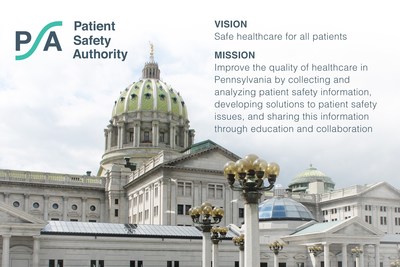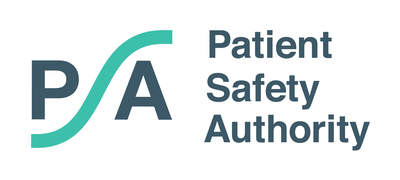|
01.05.2017 21:25:00
|
The Pennsylvania Patient Safety Authority Releases its 2016 Annual Report
HARRISBURG, Pa., May 1, 2017 /PRNewswire-USNewswire/ -- In its 2016 annual report, the Pennsylvania Patient Safety Authority recognizes the patient safety improvements made by Pennsylvania healthcare facilities, and discusses the agency's continuing efforts associated with data collection and analysis, information dissemination, education and outreach, collaborations, and partnerships. In addition, the Authority highlights aspects of its 2017–2020 strategic plan, which includes extended outreach to patients and other sectors.

In 2016, Authority board and staff engaged in the Authority's third strategic planning process, in which participants developed a mission statement, vision, and four strategic pathways of focus on (1) improving diagnosis, (2) the patient, (3) long-term care, and (4) evaluating the reporting system. While the Authority remains committed to its key programs, it also believes that expanding its outreach to patients and other areas will enhance patient safety for all patients in the Commonwealth.
"As patient safety challenges change, over time, our focus must also change," said Rachel Levine, MD, chair of the Authority board of directors. "As we carefully considered our strategic plan through 2020, we recognized that the Authority has one of the most robust reporting programs in the nation, and that aggregate data analysis, when combined with the expertise of our board and staff members, helps us to improve patient safety in the Commonwealth."
Acute healthcare facility reporting trends evident in 2016 include an overall increase in the number of events reported (255,714, up 7% from 2015). The Authority continues to observe an increasing percentage of events reported as Incidents (n = 248,166; events that do not harm the patient), rather than Serious Events (n = 7,548; events that harm the patient). The number of high-harm events (associated with permanent harm or death) continues to trend downward; of high harm events in 2016, events that may have contributed to or resulted in the patient's death is the second fewest for a full year of reporting in the program history (218, 13.8% decrease from 2015).
"The Authority has hypothesized that a decrease in reported high harm events could be associated with improvements realized in patient safety, such as a shift to earlier detection and fewer events reaching the patient and causing serious harm," said Levine. "In 2016, the Authority has also continued to observe improvements in overall Serious Event reporting since new standards went into effect in April 2015."
Nursing homes reported 27,544 healthcare-associated infection (HAI) events in 2016 (a 13% decrease from 2015), and 2016 also marked the second full year of data collection since revised reporting criteria was implemented in 2014. Some highlights of the event data include that catheter-associated urinary tract infections were the predominant urinary tract infection by rate and reported gastrointestinal infection events decreased (statistically significant) compared to such reports in 2015. Also of note, a discussed similarity in Pennsylvania and national flu trends reinforces the need for continued efforts to protect nursing home residents from flu when the incidence in the community is unusually large.
"The importance of infection control and prevention in both acute healthcare facilities and nursing homes remains a key component of the patient safety conversation. With state-wide initiatives such as antibiotic stewardship at the forefront, standardized reporting criteria to produce actionable data will be essential to current and future education efforts," said Levine.
Throughout the year, data queries from event reports led to dissemination of analysis and guidance through the Authority's journal, the Pennsylvania Patient Safety Advisory. As of December 2016, the Advisory has provided nearly 540 safety-focused articles and nearly 50 associated "toolkits" of assessment tools and education. Authority staff, patient safety professionals, and subject matter experts use a variety of Authority educational resources to engage healthcare providers and provide patient safety strategies.
In 2016, educational programs engaged nearly 10,600 participants collectively through regional/other presentations, webinars, onsite at healthcare facilities, and through the Authority's online education system. The Authority also further enhanced its patient safety liaison (PSL) outreach to reporting facilities with "Keystones" (i.e., targeted, topical outreach to facilities accompanied by consultative tools and resources).
To date, Pennsylvania healthcare facilities credit the Advisory with contributing to more than 4,650 structure and process improvements. Topics addressed during 2016 include surgical procedures, medication-related events, infection prevention, maternity, leadership, patient/family involvement, and teamwork.
While the Authority continues to strengthen its foundational efforts and strategically prepare for the future, it also proudly recognizes the value of collaborative learning. Success through 2016 in the Authority's collaborative improvement projects on targeted interventions in healthcare facilities has led to additional programs with Authority partners.
Lastly, regarding healthcare staff engagement, the Authority completed its fourth annual "I Am Patient Safety" contest in which healthcare facilities again had the opportunity to display their commitment to patient safety by nominating the outstanding patient safety efforts of their staff. The Authority recognized 14 individuals or groups from nominations from Pennsylvania facilities, all of whom are featured in the 2016 annual report.
See the Pennsylvania Patient Safety Authority's 2016 Annual Report Executive Summary, which includes links to the complete 2016 Annual Report and Executive Summary and Partnerships interactive infographics.
About the Pennsylvania Patient Safety Authority: Established under the Medical Care Availability and Reduction of Error (MCARE) Act of 2002 the Authority, an independent state agency, collects and analyzes patient safety data reported through its Pennsylvania Patient Safety Reporting System (PA-PSRS) and then provides strategies and lessons learned to healthcare facilities to improve safety and help prevent patient harm.
Mission: To improve the quality of healthcare in Pennsylvania by collecting and analyzing patient safety information, developing solutions to patient safety issues, and sharing this information through education and collaboration.
Vision: Safe healthcare for all patients.
For more information about the Authority, please visit our website at www.patientsafetyauthority.org
Like the Authority on Facebook
Follow the Authority on Twitter
Subscribe to the Authority on YouTube

To view the original version on PR Newswire, visit:http://www.prnewswire.com/news-releases/the-pennsylvania-patient-safety-authority-releases-its-2016-annual-report-300448927.html
SOURCE Pennsylvania Patient Safety Authority
 Der finanzen.at Ratgeber für Aktien!
Der finanzen.at Ratgeber für Aktien!
Wenn Sie mehr über das Thema Aktien erfahren wollen, finden Sie in unserem Ratgeber viele interessante Artikel dazu!
Jetzt informieren!